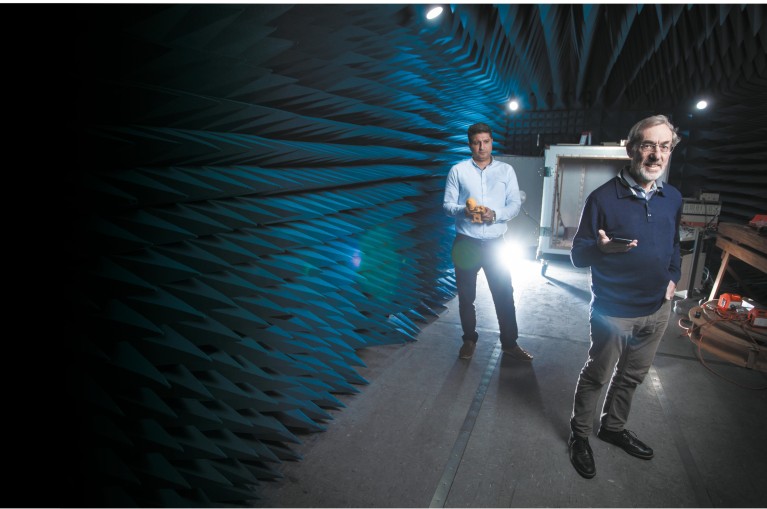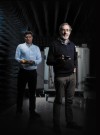Fast 5G networks are supposed to take hold in 2019, as phones, providers and networks all begin to come online. Behind the scenes, studies modelling the absorption patterns of 5G electromagnetic energy in human tissue, authored by Professor Andrew Wood’s Swinburne team, has helped form the basis for international discussions on safety regulation and design.
Wood’s team, which is part of the multi-institutional Australian Centre for Electromagnetic Bioeffects Research (ACEBR), is a key contributor to the International Commission on Non-Ionizing Radiation Protection (ICNIRP) review, which is expected to be released in 2019.

Swinburne’s anechoic chamber in its Radiofrequency Dosimetry Laboratory dampens the noise of other radio frequency (RF) signals so that Andrew Wood (right) and Alireza Lajevardipour can test energy absorption in specific regions of the body. The lab contains equipment used at the former Telstra Research Laboratories and the lab is still used by Telstra for compliance checking.© Eamon Gallagher
“We believe the main biological effect of the electromagnetic radiation from mobile phones is a rise in temperature,” Wood explains. “There are also concerns that there could be more subtle effects, such as links between long-term exposure and certain types of cancer, but while there is some evidence from epidemiological and animal studies, these remain controversial.”
5G mobile technology promises a ten-fold increase in data transmission rates compared to current 4G networks, which will be achieved by using a higher transmission frequency. The physiological effects of electromagnetic radiation change with frequency, so the advent of 5G triggered a major international review of relevant radiation safety guidelines, for which it’s agreed that there is insufficient data for a meaningful health risk assessment.
But Wood’s team have yet to see major red flags at, or below, the commonly accepted electromagnetic radiation limit in the current international standards that apply to mobile technologies.
“As the frequency goes up, the depth of penetration into biological tissues goes down, so the skin and eyes, rather than the brain, become the main organs of health concern,” Wood says. “The major hurdle is that the power levels involved in mobile and wireless telecommunications are incredibly low, which, at most, produce temperature rises in tissue of a few tenths of a degree. Picking up unambiguous biological changes is therefore very difficult.”
However, it will be important to balance the risk and reward, he notes. “Wireless technologies bring enormous benefits, and being over-cautious would potentially deny these benefits to needy communities.”
Moving forward, the team plans to continue to model the bioeffects of 5G electromagnetic radiation. Their plans for future work range from building skin models and biomolecular work on cells using fluorescent dye, to computational simulations that scale up from single cells to humans.



 GOOD CONNECTIONS: Swinburne’s network impacts everything from 5G to cosmology
GOOD CONNECTIONS: Swinburne’s network impacts everything from 5G to cosmology
 On the pulse of material fabrication
On the pulse of material fabrication
 Technology meets humanity at Swinburne
Technology meets humanity at Swinburne
 Take-home lessons on diabetes data
Take-home lessons on diabetes data